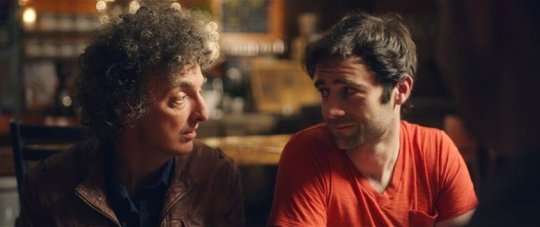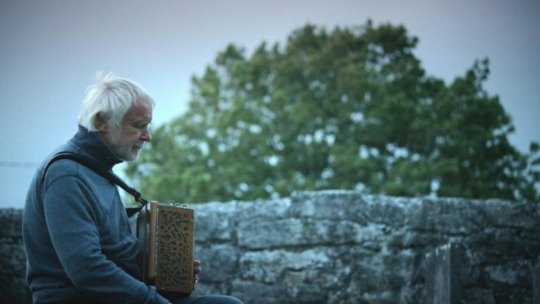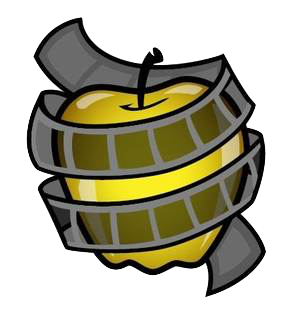#translation for non chicagoans:
Explore tagged Tumblr posts
Text
someone just walked through the red line selling loud, spotted competing sellers, then said "hey aren't yall selling squares? Someone back there wants squares!" And it was just??? Such a positive interaction I love it
#firefly talks#translation for non chicagoans:#red line = public transit train#loud = weed/blunts#squares = cigarettes#also theres what appears to be a social worker walking through the train#giving ppl their information so if they or someone they know needs help they know who to go to
1 note
·
View note
Text
New from Every Movie Has a Lesson by Don Shanahan: CAPSULE REVIEWS: 5th annual Irish American Movie Hooley

As an Chicagoan of strong Irish descent myself, let me step in and play the part of “good authority.” I have it on good authority that the annual Irish American Movie Hooley is a boisterous event with a trio of buried treasure movies that normally wouldn’t grace American screens. Just as the event’s name translates: “When a party gets rowdy, the Irish call it a ‘hooley.’” You need to join the 5th edition of this artistic autumnal party at The Gene Siskel Film Center over the weekend of September 27–29. Come for the scene. Consume some friendly and fascinating culture.
Barbara Scharres, the Director of Programming for The Gene Siskel Film Center in Chicago, and Irish American radio personality Mike Houlihan recently announced the three choice selections for the upcoming fifth annual mini-festival. All three are making their Chicago premiere with one American premiere to close the weekend slate.
MISTY BUTTON

(Image: imdb.com)
Misty Button shows us that the whole “starving artist” trope of creative individuals being lousy f–kups with commitment issues is not solely an American pitfall. It bites the Irish too. The protagonist matching these well-worn traits is James, played by Cillian O’Sullivan. To say he lands in a pickle in Misty Button would be an understatement. It’s more like an inescapable vice tightening so hard the soaked-in whiskey squirts out of his pores in this slow-building dark comedy caper.
James and his uncorrected troubles reside in the far northern Bronx neighborhood of Woodlawn, known for its “Emerald Isle” turf of Irish-American heritage. He meets the burdens of his working class life with a triple-dipped punch of groans, signs, and bursts of profanity. In the course of a single day after finding the bottom of another bottle of Jameson, James is canned from his bar job and living single when his wife Hayley (Hannah Jane McMurry) tosses her rings out the window. Naturally, the impulsive James stoked his own fire to burn every bridge in each of these transpired events. When doesn’t lament in a shot glass, he does so seated at a typewriter trying to write something that gets him discovered.
James and his friends Declan (Patrick Scherrer) and Eoin (Shaun Kennedy) get their ears bent by little rants emanating from Timmy Thomas, a loquacious bard of a man played by John Keating (recognized from last year’s Hooley entry Emerald City), sitting in the same tavern. The twitchy, orange-eating middle-aged man propositions James and Eoin to do the legwork of placing a $10,000 bet on a 35-1 local racehorse named Misty Button. When the two mates blow some of the money on drugs and miss the betting window, they now find themselves in debt to a local crime bully Alonzo (Bret Lada). Worst of all, instead of owing just the $10,000, they owe 35 times that because the titular longshot ended up winning the race, costing all involved a tremendously larger windfall of cash.
The hijinks that ensue from the script and direction of filmmaker Seanie Surgue (making his feature debut after an emerging career in short films) put James, Eoin, and Timmy Thomas through a bungled wringer. Barstool banter turns into double-crosses. Swindles turn into smash-and-grab heists. Roughed up bumps and bruises meant to teach a lesson or two turn into murder. O’Sullivan, often looking and sounding like Colin Farrell Lite, smolders and shouts his way through these increasing obstacles. The scene-stealer is always the wiry Keating. The line delivery and physical quirks of his yarns are infectious.
This is, admittedly for a long stretch, a meandering way to encircle a drain of comeuppance. Misty Button is low on its expressions of suspense and does not employ a musical score to define any consistent tone. You have to hang on words and narrative beats. Not all of that meshes smoothly or free from head-scratching character choices.
Just when Misty Button seems like it runs out calamities to justify where it’s going, the double-crosses emerging from the previously mentioned banter flip the movie (and you) on its ear. The wild third act twists are a saving grace that redeem what was messy and turns it into a clever hustle primed to be backed often by “The Rocky Road to Dublin” by The Dubliners. Come to be pleasantly surprised.
MILD RECOMMENDATION
youtube
THE MAN WHO WANTED TO FLY

(Image: youtube.com)
COMING SOON!
youtube
CUMAR: A GALWAY RHAPSODY

(Image: siskelfilmcenter.org)
Annually and without fail, the Irish American Movie Holley delivers a gorgeously appointed documentary among the trio of features that either fascinates with an affecting citizen testimony or astonishes us with the natural beauty of the Emerald Isle. Cumar: A Galway Rhapsody is a poetic and dazzling example of the later sample of non-fiction art. With soaring cinematography across streets, surf, and sky, every inch of this documentary drips with the heavenly chemistry of its fine and proud home country.
Directed by Aodh O Coileain, Cumar: A Galway Rhapsody chronicles the layers of culture and natural wonders in and around the western city of its title. Galway, the sixth most populous city of the country, will be the year-long title-holder of the European City of Culture next year in 2020, and this film shows many of the rich reasons why it was sought for that distinction. A collection of six artists perform and explore the cultural nuance alongside the flowing stream of visuals.
Those featured artists include writer Mike McCormack, poet Rita Ann Higgins, singer Róisín Seoighe, street theatre director Noeline Kavanagh, visual artist Pádraic Reaney and musician Máirtín O’Connor. A seventh comes from the narration of comedian Tommy Tiernan which adds context and character to the scenes observed. The last topping bow of auditory presentation comes from composer Jake Morgan and music from Matthew Berrill and Nicola Geddes.
The title word “cumar” translates to “confluence.” In its most natural definition, confluence refers to where multiple waters converge. In Galway’s case, that matches the River Corrib and the churning bays washed by the Atlantic Ocean. Through labeled sections, Cumar: A Galway Rhapsody one of those artists is highlighted and the various sub-definitions of cumar and confluence preface each vignette. Some of those thematic pinpoints include cumar as “the accord between the artist and his tools, the energy that binds the ensemble, the influence of a place on the human spirit, and the unity that stems from a gathering of people.
With this draping chapters, Cumar: A Galway Rhapsody is well-paced and patient with unwrapping its historical notes and asides. Each chapter is an anecdote to the soul of the people. Parallel to the human element, each chapter, as well, is an earthly sermon to the land and sea. This is a fine credit to O Coileain and his editing team which included Conall de Cleir and Oisin Misteil.
The true feast of this documentary is the serene photography. Fast and slow, the blend of urban and domestic landscapes is observational and pastoral. Near and far, the film is lifted even greater by the wondrous aerial photography captured by Roman Bugovskiy and fleet of cameras. Theatrical screens will fill with this imagery and evoke dreams of reaching out and touching these divine treasures. That is an impressive treat and feat to enjoy at the Irish American Movie Hooley.
HIGH RECOMMENDATION
youtube
Paddy’s Irish Whiskey will offer a sampling station in the lobby of the Gene Siskel Film Center before each screening, and also hold a free “whiskey raffle” after each screening and award a complimentary bottle of Paddy’s Irish Whiskey to the winner. After the Misty Button screening, director Seanie Sugrue will be in attendance for a talkback. As an added perk, the welcome audience is invited to an opening night reception at The Emerald Loop Bar and Grill, 216 N. Wabash Ave., immediately after the film, with complimentary Paddy’s Irish Whiskey.
For more information about the Movie Hooley, visit: http://moviehooley.org
All screenings and events are at the Gene Siskel Film Center of the School of the Art Institute of Chicago, located at 164 N. State St.
Tickets to each screening — unless stated otherwise — are $12/general admission, $7/students, $6/Film Center members, and $5/Art Institute of Chicago (AIC) staff and School of the Art Institute of Chicago (SAIC) faculty, staff, and students. All tickets may be purchased at the Film Center Box Office. Both general admission and Film Center member tickets are available through the Gene Siskel Film Center’s website.


LOGO DESIGNED BY MEENTS ILLUSTRATED
Permalink
from REVIEW BLOG – Every Movie Has a Lesson https://ift.tt/2mOxma0 via IFTTT
from WordPress https://ift.tt/2lSuQzF via IFTTT
0 notes
Photo

Part 5: Queer Latina Organizing in Chicago
Two groups that recognized the need for queer Latina organizations in Chicago were LLENA (Latina Lesbians en Nuestro Ambiente) and Amigas Latinas. These two organizations served as safe social space and enacted social change on issues that were pertinent to queer Latinas in Chicago.
LLENA, the first organization created by and for lesbian Latinas in Chicago ran from 1988-1992 (Torres 1). The group began when Latina lesbians found that they were not welcomed neither within their own ethnic communities nor queer, white spaces. In 1987, a Mexican-born woman Maria Amparo Jiménez placed an advertisement in Outlines, a queer Chicago newspaper, calling for a meeting of Latina lesbians (Torres 2). The group quickly grew as never before had there been a local space that Latina lesbians could gather safely and without having to sacrifice one identity to nurture the other. While the acronym for LLENA does stay for Latina Lesbians in Our Environment, the direct Spanish-to-English translation for LLENA means “full.” This sense of unity truly made the group’s members feel full.
Because LLENA attracted any and every Latina lesbian to its spaces, members were diverse in age, race, citizenship status, education levels, and language access (Torres 3). While diversity within their group was valuable and remarkable, this often led to conflicts of interest within the group, making it difficult for LLENA to organize effectively (Torres 3-6). Though each year the group sought to become more accessible to its members by holding bilingual meetings, holding meetings in predominately Latinx neighborhoods, and more, the group was often dominated by its more privileged members (Torres 4-5, 10). Members clashed when deciding whether the group should be for socializing or for enacting social change; often the white, more educated Latinas pushed for socializing (Torres 4-5, 10). Additionally, the group struggled with finding a collective, visible stance as some members were closeted or undocumented and could not participate in activism and/or social events, causing more tension (Torres 10). Other tensions arose from the fact that Jiménez, a, “non-Chicagoan,” became the spokesperson for the group, often having to speak on the behalf of Latina lesbians in Chicago (Torres 4). Throughout all of this conflict, though, LLENA was able to create a space for Latina lesbians in Chicago to come together and to fight for issues that impacted all aspects of their identity (Torres 9-11). Because of the diversity of the group, LLENA prioritized the need for an intersectional lesbian feminist movement on a national and international level (Torres 9-10). Though the group tensions eventually led the group to dissolve, LLENA certainly laid out impressive groundwork when it comes to social and activism-based organizing in Chicago outside of bars for queer Latinas. Amigas Latinas, LLENA’s successor, aimed to expand on the foundations that LLENA set.
Amigas Latinas was a more accessible and focused version of LLENA. The group ran from 1995-2015, starting out as a social group for queer Latinas — not lesbians specifically like LLENA emphasized. Rather than being started by one person like LLENA, Amigas Latinas was, co-founded, “... by Evette Cardona, Mona Noriega, Alicia Amador, Aurora Pineda, Karen Rothstein-Pineda, Norma Seledon, Mary Torres and Lydia Vega,” (Maxwell). The group started out having monthly meetings before eventually branding itself as an organization (LGBT Hall of Fame). From its inception, the group valued discussion and protected its most vulnerable members. Amigas Latinas was a democracy, voting for new board members every year, ensuring that no tensions arose from having a single ruler (Maxwell). The organization created successful social events, offered services to LGBTQIA+ Latinas, established scholarship programs, worked with government officials, conducted never-before-done studies on queer Latina populations, and more (Maxwell). Amigas Latinas also established various groups within the organization that better served more specific identities such as, “Amiguitas Youth Group (... for LBTQQ Latina adolescents and young adults), Entre Familia (a Spanish-speaking safe environment for parents and friends of LGBT persons) … Projecto Basta (training programs for professionals and nonprofits who work in mental health, substance abuse, and domestic violence),” and more (LGBT Hall of Fame). Though the group was more successful on paper than LLENA in terms of their impact how long it lasted, this was mostly made possible due to the certain level of respectability politics utilized by Amigas Latinas. The group, while it did aim to enact change within the Chicago community, did not do so radically. Amigas Latinas worked with government officials, some members eventually taking office such as Mona Noriega becoming the chair and commissioner of the Commission on Human Relations for the City of Chicago (Maxwell). Regardless of respectability politics, the group did serve as a safe space and offered a great deal of support to queer Latinas in Chicago who would have otherwise struggled to find each other. Though Amigas Latinas did not make any radical changes, they were a great model for more modern organizations to build upon.
Works Cited
Torres, Lourdes. Latina Lesbian Organizing In Chicago Queering the Midwest Conference.Sept.2010,beckresearch.org/wp-content/uploads/2011/05/Queering-Midwest-Conference-Presentation-Latina-Lesbian-Organizing-in-Chicago.pdf.
Maxwell, Carrie. “Leaders reflect on activism as Amigas Latinas folds - Gay Lesbian Bi Trans News Archive.” Windy City Times, Windy City Times, 8 July 2015, www.windycitymediagroup.com/lgbt/Leaders-reflect-on-activism-as-Amigas-Latinas-folds/52086.html.
“LGBT HALL OF FAME — AMIGAS LATINAS.” Chicago LGBT Hall of Fame, 2016, chicagolgbthalloffame.org/amigas-latinas/.
IMAGE
1 note
·
View note
Audio
SERENGETI as Kenny Dennis - "Crush em" (Prod. by Odd Nosdam) by anticon from the Kenny Dennis LP, out June 25, 2013. --- You don’t want to mess with Kenny Dennis. Even at the age of 50, the bratwurst downing, Brian Dennehy-worshipping rapper can run a mile in 4:14. The KDz remains the most feared slugger on the softball diamond. And he can still take Nitro from American Gladiators on in a game of Powerball. That’s just Kenny. This is the Kenny Dennis LP, the sequel to last year’s self-titled EP. Released on Anticon, it furthers Serengeti’s hilarious, absurdist, and subtly humane saga of a Chicago-born man with a Mike Ditka mustache, whose lovable delusions and diehard loyalty fall somewhere between Homer Simpson and a Bill Swerski Superfan. “Kenny’s just telling current stories,” Serengeti says about his alter ego. “He wants to give people a heads up and offer some life advice. ‘Hey listen up to me, I’m wise.’ He’s getting more confident, even though he always was confident.” If you’re just tuning into the chronicles of Kenny, there are a few things you need to know. First off: Kenny Dennis was once in Tha Grimm Teachaz during the Golden Age of the early 90s. Signed to Jive, the Teachaz learned record industry rule #4,080 and were dropped from the label, but not before Kenny feuded with Shaquille O’ Neal, who was performing with the Fu-Schnickens during the 1993 Jive Records Showcase in Philadelphia. Shaq mocked Kenny’s stache. This was a grave error. Kenny returned with a vengeance on 2006’s cult classic Dennehy,. Since then, the character created by David Cohn has re-appeared on Conversations with Kenny and the “original never-released” Grimm Teachaz Record, There’s a Situation on the Homefront. But the KDz really hit his stride as an MC on last year’s eponymous EP, which Pitchfork raved as being “half Prince Paul, half-Waiting for Guffman.“ Lest you mistake Serengeti for a joke artist, 2011’s Family & Friends and 2012’s C.A.R. found the prolific Chicagoan writing some of the most self-deprecating and sorrowful looks at addiction and image transformation in recent memory. He’s collaborated with celebrated underground artists like Sufjan Stevens, Matthewdavid, and Yoni Wolf of Why? Robert Christgau, the dean of American music critics, has given all but one of his records “A” scores and openly wondered: “Is there anyone else who can do this?” But there’s only one Kenny Dennis and he’s back to give you some direction—straight up, no O’ Doul’s chaser. The Kenny Dennis LP is full of jewels of wisdom, the tender love story Kenny and his wife Jueles, and the longtime friendship between Kenny and Ders (Anders Holm from Workaholics, a Kenny fan who appears in four skits). The beats come from Odd Nosdam and cast a similarly bizarro re-working of boom-bap, blending rugged beat breaks, sci-fi synths, and scratches courtesy of Jel. “Kenny’s rapping the only way that he knows how. He’s not really current with what’s happening in the game. This is his take on rap and everything that influences him on his day-to-day life schedule,” Serengeti says. “He’s a man rapping because he loves to rap and he cares for people, wants to spread wisdom. He’s not preaching; he’s just calling it the way he sees it. Kenny Dennis might be “normal,” but Serengeti’s creativity is unrivaled. As bizarre as it is brilliant, it’s like the deranged comic vision of an imaginary super group comprised of Andy Kauffman, Mellow Gold-era Beck, and MF Doom. The raps on The Kenny Dennis LP are stream-of-consciousness rants about how if you “like it, you bang ‘em,” (“Bang Em”), which Kenny translates into a metaphor about how you got to get up and do something. He also denies being a vegan. “Punks” finds him mumbling disses aimed at everyone from imaginary rivals to professional wrestler, Leaping Lanny Poffo. “Crush ‘Em” finds Kenny breaking down the inventions of the English (boxing, tennis golf) vs. those of Americans (football, beef, leg stockings). Interspersed with the songs is the narrative between Kenny and Ders, who he met around 1988 at the Sharper Image on Michigan Ave. While futilely attempting to return a non-fogging shaving mirror, Kenny noticed the young Ders and generously bestowed him with a shower radio (“a good piece of merchandise.”) It traces the relationship to Kenny’s 50th birthday at the Ruth’s Chris Steakhouse in California, full of celebrity guests and sinister Shaquille O’ Neal fans. This is Kenny as he stands today. 50 years old. Still furious and even funnier. The best friend you ever had, so long as you don’t wear a Shaq jersey in his vicinity.
0 notes